Pull-Through Behavior of Novel Additively Manufactured Sandwich Composite Inserts
Abstract
:1. Introduction
2. Experimental Analysis
3. Numerical Analysis
4. Results and Discussion
5. Conclusions
Author Contributions
Funding
Institutional Review Board Statement
Informed Consent Statement
Data Availability Statement
Acknowledgments
Conflicts of Interest
References
- Schwennen, J.; Sessner, V.; Fleischer, J. A New Approach on Integrating Joining Inserts for Composite Sandwich Structures with Foam Cores. Procedia CIRP 2016, 44, 310–315. [Google Scholar] [CrossRef]
- Thomsen, O.T.; Rits, W. Analysis and design of sandwich plates with inserts—A high-order sandwich plate theory approach. Compos. Part B Eng. 1998, 29, 795–807. [Google Scholar] [CrossRef]
- Allen, H.G. Analysis and Design of Structural Sandwich Panels; Pergamon Press Ltd.: Oxford, UK, 1969. [Google Scholar]
- Plantema, F.J. Sandwich Construction; Wiley: New York, NY, USA, 1966. [Google Scholar]
- Zenkert, D. An Introduction to Sandwich Construction; Chameleon Press: London, UK, 1995. [Google Scholar]
- Librescu, L. Elastostatic and Kinetics of Anisotropic and Heterogeneous Shell-Type Structures; Noordhoff: Leyden, The Netherland, 1975. [Google Scholar]
- Frostig, Y.; Baruch, M. Bending of sandwich beams with transversely flexible core. AIAA J. 1990, 28, 523–531. [Google Scholar] [CrossRef]
- Frostig, Y. On stress concentration in the bending of sandwich beams with transversely flexible core. Compos. Struct. 1993, 24, 161–169. [Google Scholar] [CrossRef]
- Frostig, Y.; Shenhar, Y. High-order bending of sandwich beams with a transversely flexible core and unsymmetrical laminated composite skins. Compos. Eng. 1995, 5, 405–414. [Google Scholar] [CrossRef]
- Thomsen, O.T. Sandwich plates with ‘through-the-thickness’ and ‘fully potted’ inserts: Evaluation of differences in structural performance. Compos. Struct. 1997, 40, 159–174. [Google Scholar] [CrossRef]
- Bozhevolnaya, E.; Thomsen, O.T.; Kildegaard, A.; Skvortsov, V. Local effects across core junctions in sandwich panels. Compos. Part B Eng. 2003, 34, 509–517. [Google Scholar] [CrossRef]
- Bozhevolnaya, E.; Lyckegaard, A.; Thomsen, O.T.; Skvortsov, V. Local effects in the vicinity of inserts in sandwich panels. Compos. Part B Eng. 2004, 35, 619–627. [Google Scholar] [CrossRef]
- Huang, S.-J.; Chiu, L.-W. Modeling of Structural Sandwich Plates with ‘Through-the-Thickness’ Inserts: Five-Layer Theory. Comput. Model. Eng. Sci. 2008, 34, 1–32. [Google Scholar]
- Bunyawanichakul, P.; Castanie, B.; Barrau, J.J. Experimental and Numerical Analysis of Inserts in Sandwich Structures. Appl. Compos. Mater. 2005, 12, 177–191. [Google Scholar] [CrossRef]
- Bianchi, G.; Aglietti, G.S.; Richardson, G. Static Performance of Hot Bonded and Cold Bonded Inserts in Honeycomb Panels. J. Sandw. Struct. Mater. 2011, 13, 59–82. [Google Scholar] [CrossRef]
- Raghu, N.; Battley, M.; Southward, T. Strength Variability of Inserts in Sandwich Panels. J. Sandw. Struct. Mater. 2009, 11, 501–517. [Google Scholar] [CrossRef]
- Kim, B.J.; Lee, D.G. Characteristics of joining inserts for composite sandwich panels. Compos. Struct. 2008, 86, 55–60. [Google Scholar] [CrossRef]
- Song, K.I.; Choi, J.Y.; Kweon, J.H.; Choi, J.H.; Kim, K.S. An experimental study of the insert joint strength of composite sandwich structures. Compos. Struct. 2008, 86, 107–113. [Google Scholar] [CrossRef]
- Schwan, L.; Schwenke, J.; Hartwich, T.S.; Krause, D. Virtual Testing of Honeycomb Sandwich Structures with Multiple Load Introduction Points. In Proceedings of the 20th European Conference on Composite Materials, ECCM 2022, Lausanne, Switzerland, 26–30 June 2022. [Google Scholar]
- Bozhevolnaya, E.; Lyckegaard, A. Local effects at core junctions of sandwich structures under different types of loads. Compos. Struct. 2006, 73, 24–32. [Google Scholar] [CrossRef]
- Bunyawanichakul, P.; Castanié, B.; Barrau, J.J. Non-linear finite element analysis of inserts in composite sandwich structures. Compos. Part B Eng. 2008, 39, 1077–1092. [Google Scholar] [CrossRef]
- Burchardt, C. Fatigue of sandwich structures with inserts. Compos. Struct. 1997, 40, 201–211. [Google Scholar] [CrossRef]
- Slimane, S.; Kebdani, S.; Boudjemai, A.; Slimane, A. Effect of position of tension-loaded inserts on honeycomb panels used for space applications. Int. J. Interact. Design Manuf. (IJIDeM) 2018, 12, 393–408. [Google Scholar] [CrossRef]
- Sahu, S.K.; Sreekanth, P.S.R.; Reddy, S.V.K. A Brief Review on Advanced Sandwich Structures with Customized Design Core and Composite Face Sheet. Polymers 2022, 14, 4267. [Google Scholar] [CrossRef] [PubMed]
- Crépin, D. Toward toughness improvement of foam core sandwich panel inserts through an energy approach. Eur. J. Mech.—A/Solids 2022, 94, 104575. [Google Scholar] [CrossRef]
- Relea, E.; Weiss, L.; Kussmaul, R.; Zogg, M.; Ramstein, G.; Wegener, K. Precisely Adjustable Inserts for Stiffness-Driven CFRP Sandwich Structures. Procedia CIRP 2017, 66, 294–299. [Google Scholar] [CrossRef]
- Türk, D.A.; Kussmaul, R.; Zogg, M.; Klahn, C.; Leutenecker-Twelsiek, B.; Meboldt, M. Composites Part Production with Additive Manufacturing Technologies. Procedia CIRP 2017, 66, 306–311. [Google Scholar] [CrossRef]
- Troschitz, J.; Kupfer, R.; Gude, M. Process-integrated embedding of metal inserts in continuous fibre reinforced thermoplastics. Procedia CIRP 2019, 85, 84–89. [Google Scholar] [CrossRef]
- Bozhevolnaya, E.; Lyckegaard, A. Structurally graded core inserts in sandwich panels. Compos. Struct. 2005, 68, 23–29. [Google Scholar] [CrossRef]
- Baptista, R.J.; Pragana, J.P.; Bragança, I.M.; Silva, C.M.; Martins, P.A. Joining metal-polymer sandwich composite sheets with mechanical nuggets. CIRP Ann. 2020, 69, 249–252. [Google Scholar] [CrossRef]
- Naik, N.K.; Rao, G.N.; Agarwal, U.; Raju, K.A.; Pottigar, S.A.; Suresh, V. Sandwich structures with composite inserts: Experimental studies. Polym. Compos. 2009, 30, 639–648. [Google Scholar] [CrossRef]
- Richert, P.; Dafnis, A.; Schröder, K.-U. Design guidelines for load introduction points at the boundaries of sandwich panels. Fatigue Fract. Eng. Mater. Struct. 2019, 42, 1510–1520. [Google Scholar] [CrossRef]
- Ferrari, M. Structurally Optimized and Additively Manufactured Inserts for Sandwich Panels of Spacecraft Structures. Master’s Thesis, ETH Zurich, Zurich, Switzerland, 2015. [Google Scholar]
- Campbell, L. SLM Components in CFRP Composite Assemblies; University of Western Australia: Perth, Australia, 2014. [Google Scholar]
- Gafner, F. Mit Additiven Verfahren Hergestellte Krafteinleitungselemente fur Sandwichstrukturen; ETH-Zurich: Zurich, Switzerland, 2014. [Google Scholar]
- Dumitrescu, A.; Walker, S.; Bhaskar, A. Manufacturing and failure modes of ALSI10MG 3D printed sandwich panel inserts. In Proceedings of the 17th European Conference on Spacecraft Structures, Materials and Environmental Testing, Toulouse, France, 28–30 March 2023. [Google Scholar]
- Dumitrescu, A.; Walker, S.J.; Romei, F.; Bhaskar, A. Design and structural testing of 3D printed honeycomb cores with optimised integrated blended inserts. J. Sandw. Struct. Mater. 2023, 10996362231210961. [Google Scholar] [CrossRef]
- Aguilar, D.; Christensen, S.; Fox, E.J. 3-D Printed Ultem 9085 Testing and Analysis. In Proceedings of the ISS R&D Conference, Boston, MA, USA, 6–9 July 2015. [Google Scholar]
- Gallagher, W.R. Investigation of Ultem 9085 for Use in Printed Orbital Structures; Department of Aeronautics and Astronautics, Wright-Patterson Air Force Base: Dayton, OH, USA, 2020. [Google Scholar]
- Gebisa, A.W.; Lemu, H.G. Influence of 3D Printing FDM Process Parameters on Tensile Property of ULTEM 9085. Procedia Manuf. 2019, 30, 331–338. [Google Scholar] [CrossRef]
- Zaldivar, R.J.; Witkin, D.B.; McLouth, T.; Patel, D.N.; Schmitt, K.; Nokes, J.P. Influence of processing and orientation print effects on the mechanical and thermal behavior of 3D-Printed ULTEM® 9085 Material. Addit. Manuf. 2017, 13, 71–80. [Google Scholar] [CrossRef]
- Bagsik, A.; Schöppner, V. Mechanical properties of fused deposition modeling parts manufactured with ultem. In Proceedings of the 69th Annual Technical Conference of the Society of Plastics Engineers, Boston, MA, USA, 1–5 May 2011; Volume 2, pp. 1–5. [Google Scholar]
- Hossain, M.A.; Zhumabekova, A.; Paul, S.C.; Kim, J.R. A Review of 3D Printing in Construction and its Impact on the Labor Market. Sustainability 2020, 12, 8492. [Google Scholar] [CrossRef]
- Chuang, K.C.; Grady, J.E.; Draper, R.D.; Shin, E.S.E.; Patterson, C.; Santelle, T.D. Additive Manufacturing and Characterization of Ultem Polymers and Composites. In Proceedings of the CAMX Conference Proceedings, Dallas, TX, USA, 26–29 October 2015. [Google Scholar]
- Tomblin, J.; Sherraden, J.; Seneviratne, W.; Raju, K.S. Advanced General Aviation Transport Experiments. A-Basis and B-Basis Design Allowables for Epoxy-Based Prepreg TORAY T700SC-12K-50C#2510 Plain Weave Fabric; National Institute for Aviation Research Wichita State University: Wichita, KS, USA, 2002. [Google Scholar]
- Corporation, H. HexWeb CRIII: Corrosion Resistant Specification Grade Aluminum Honeycomb; Hexcel Corporation: Stamford, CT, USA, 2017. [Google Scholar]
- Corporation, S.-L. Analysis and Design of Structural Sandwich Panels; H.B. Fuller Company: St. Paul, MN, USA, 1996. [Google Scholar]
- Wu, C.M.; Cheng, Y.C.; Lai, W.Y.; Chen, P.H.; Way, T.D. Friction and Wear Performance of Staple Carbon Fabric-Reinforced Composites: Effects of Surface Topography. Polymer 2020, 12, 141. [Google Scholar] [CrossRef] [PubMed]
- Oberg, E.; Jones, F.D.; Horton, H.L.; Ryffel, H.H. Machinery’s Handbook: A Reference Book for the Mechanical Engineer, Designer, Manufacturing Engineer, Draftsman, Toolmaker, and Machinist, 23rd ed.; Industrial Press: New York, NY, USA, 1988. [Google Scholar]
- Kohnke, P. Ansys Theory Reference; ANSYS: Canonsburg, PA, USA, 2020. [Google Scholar]
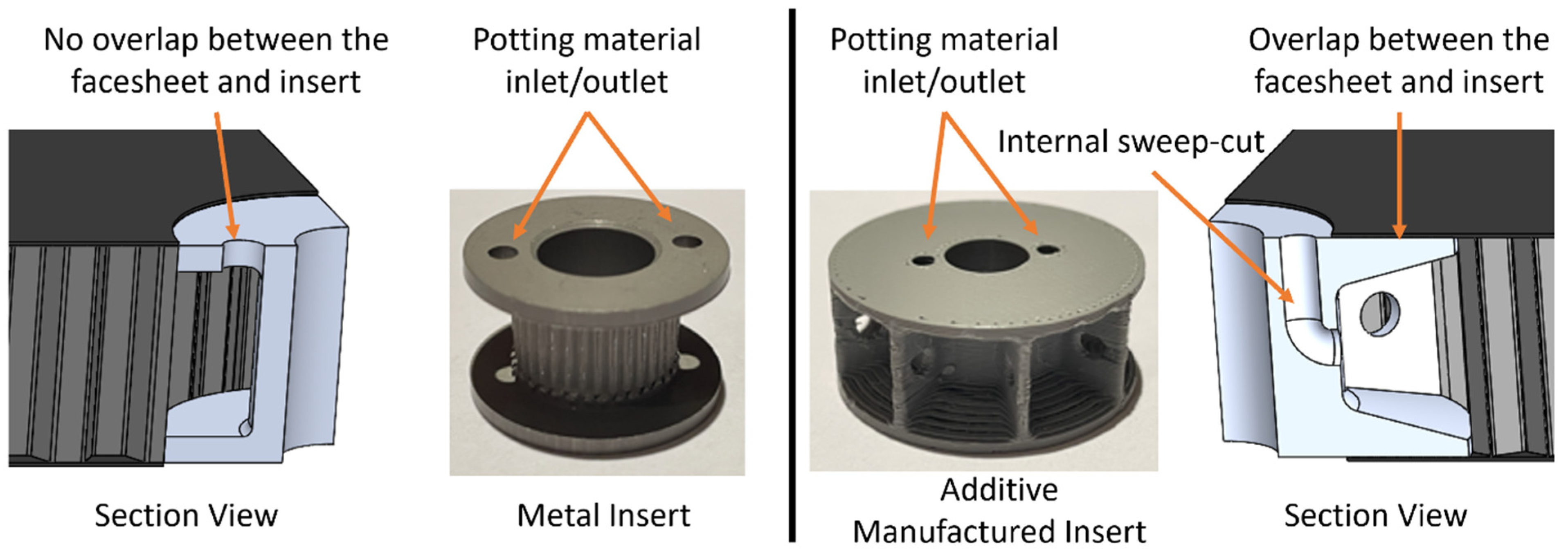
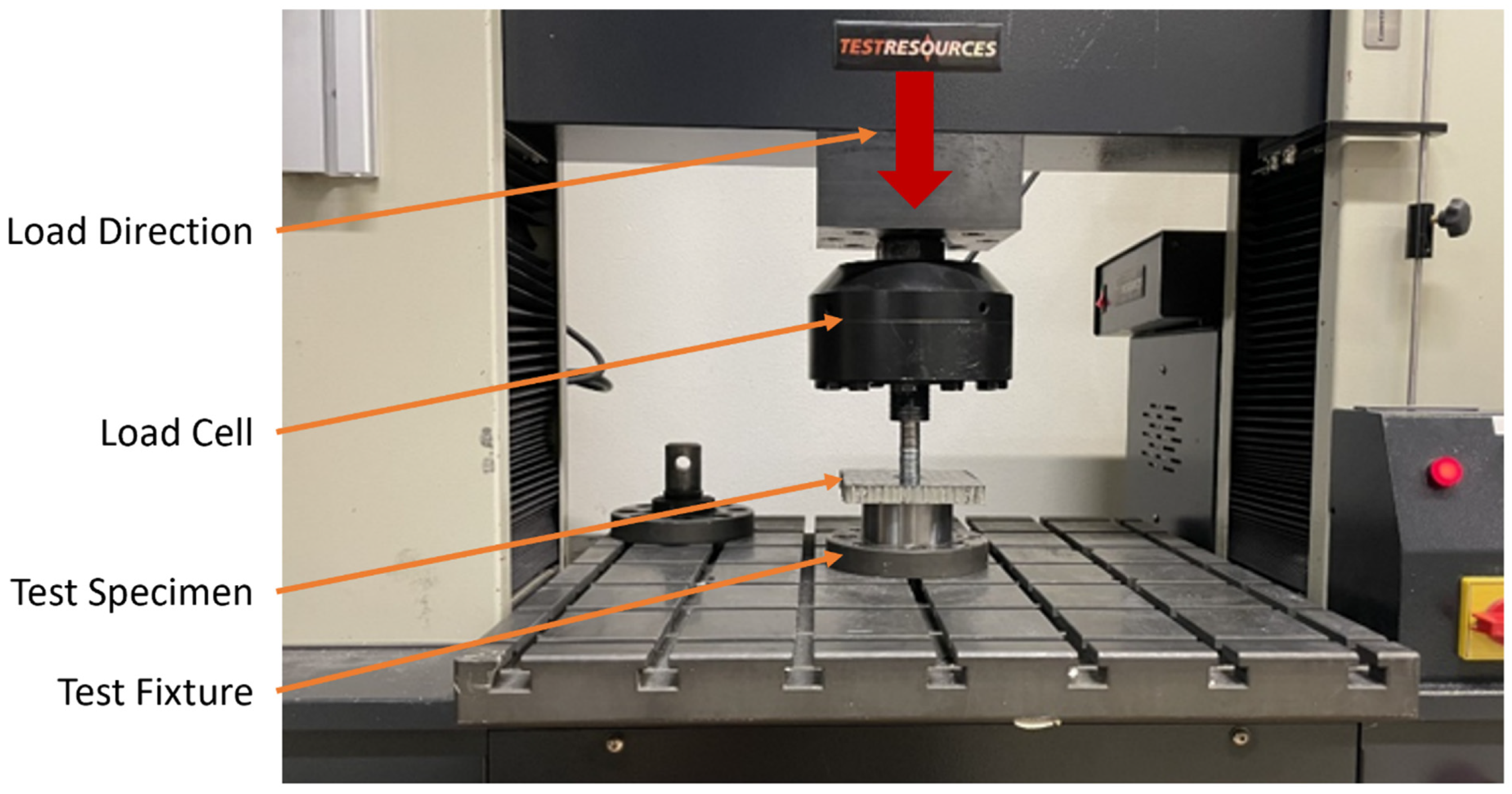
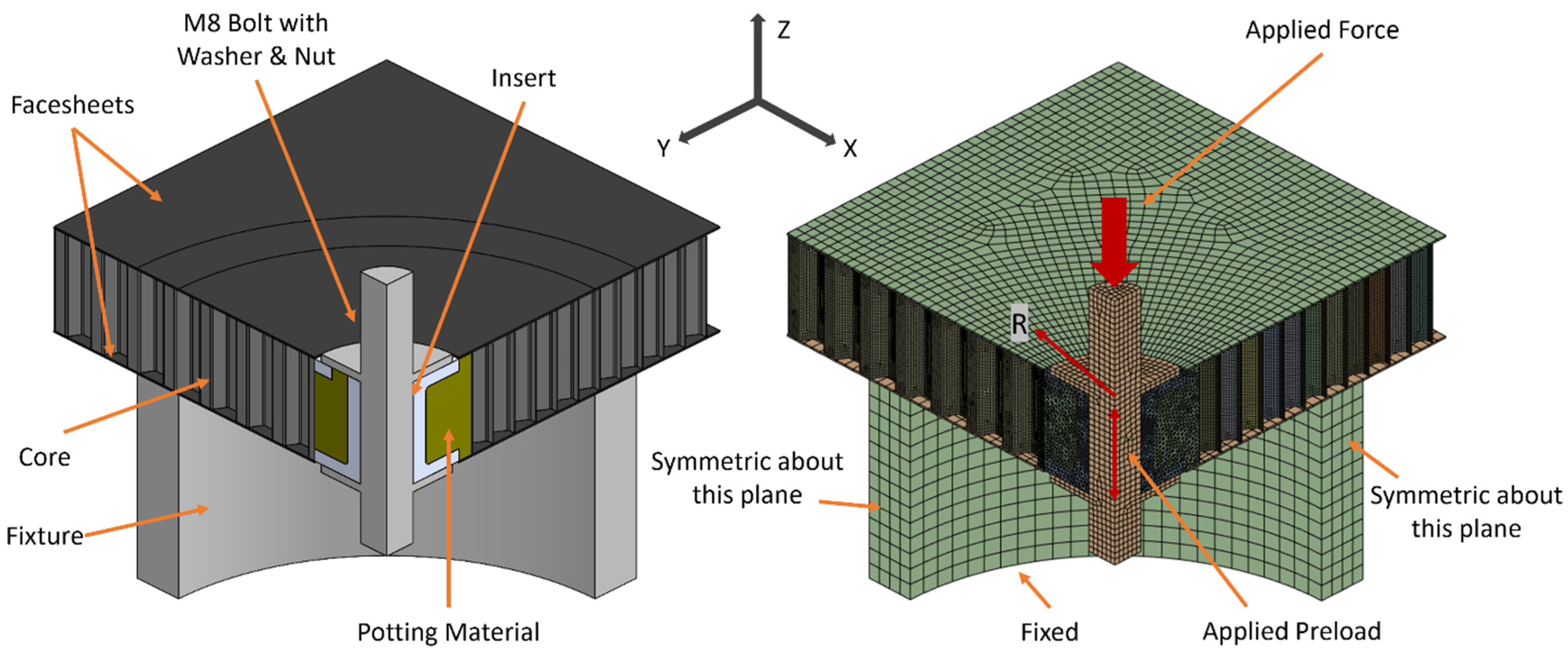
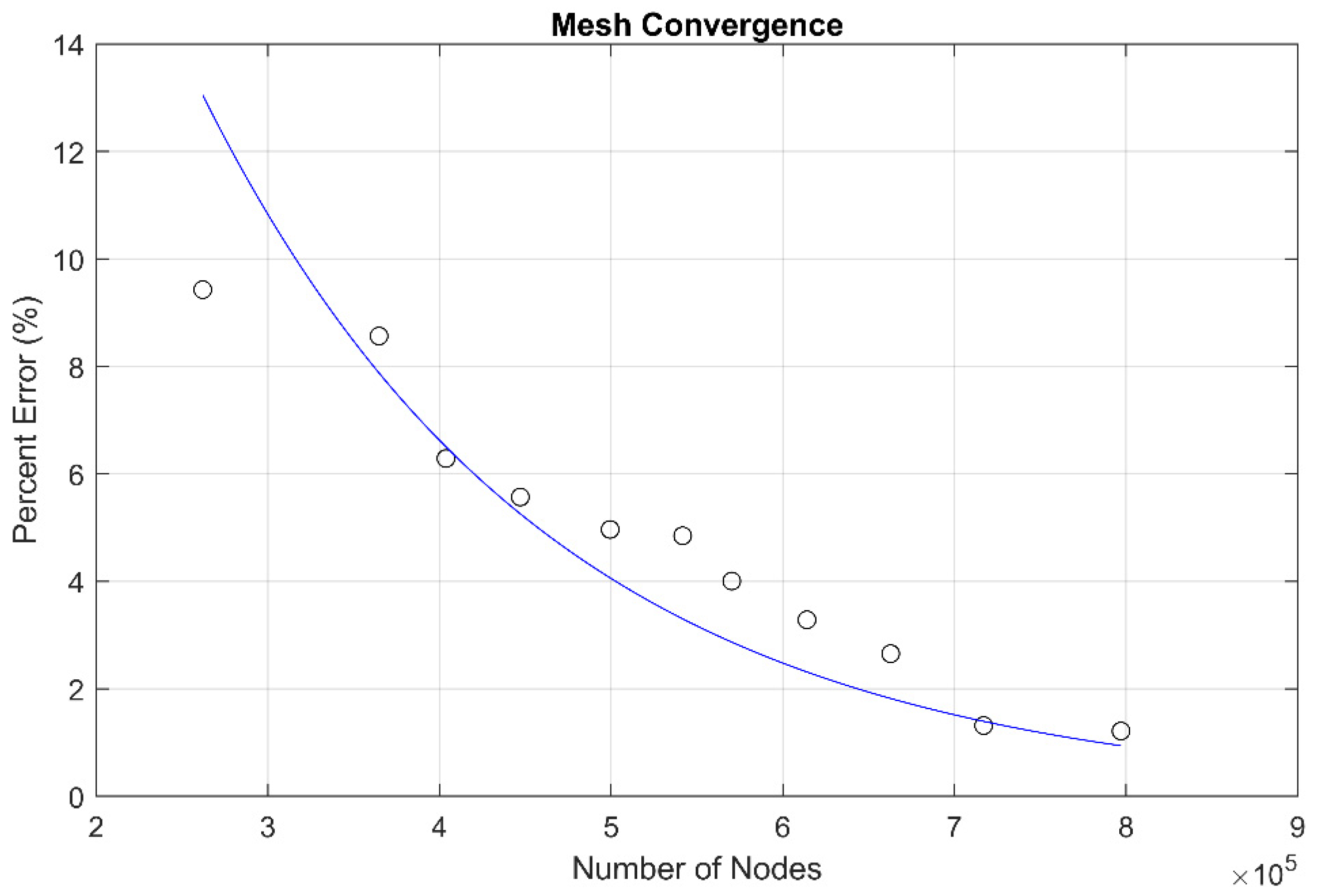

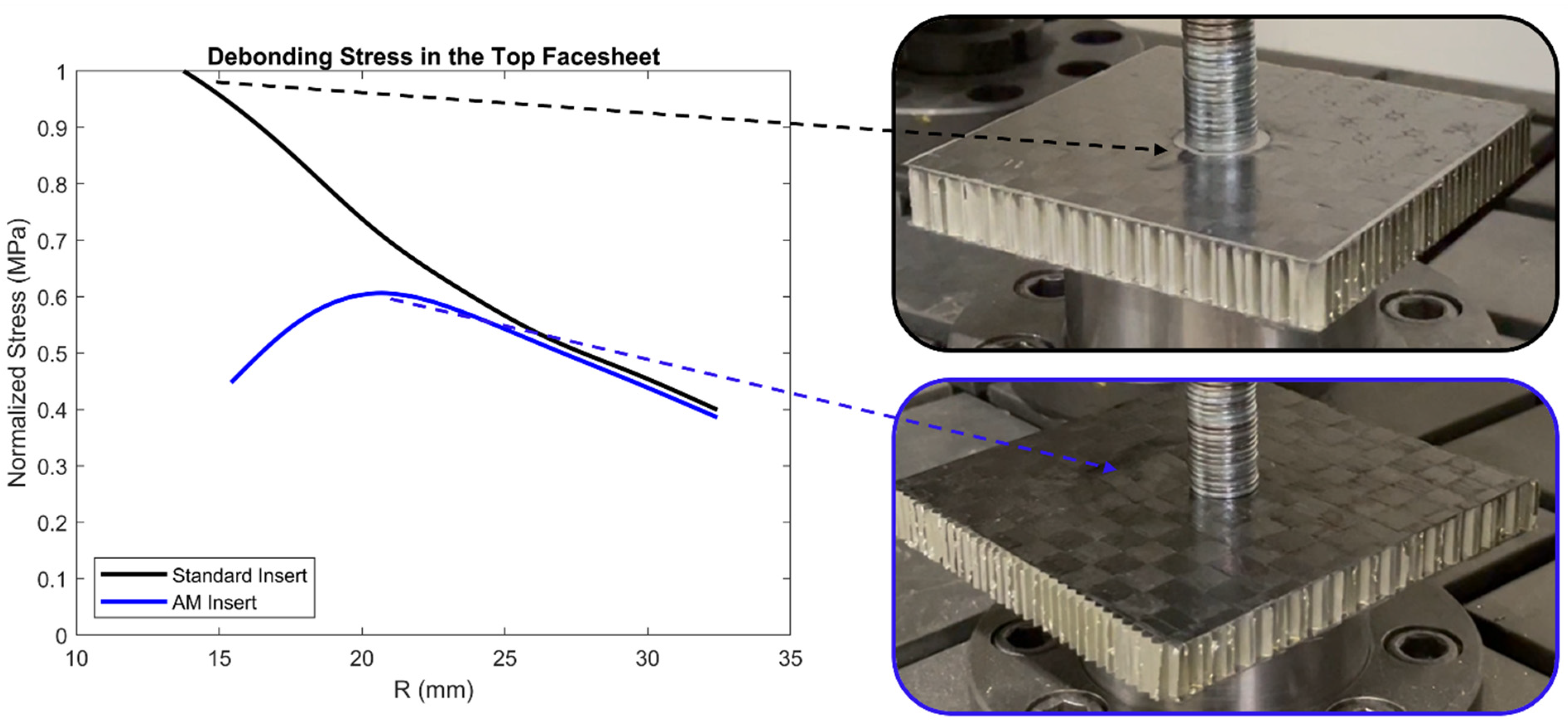
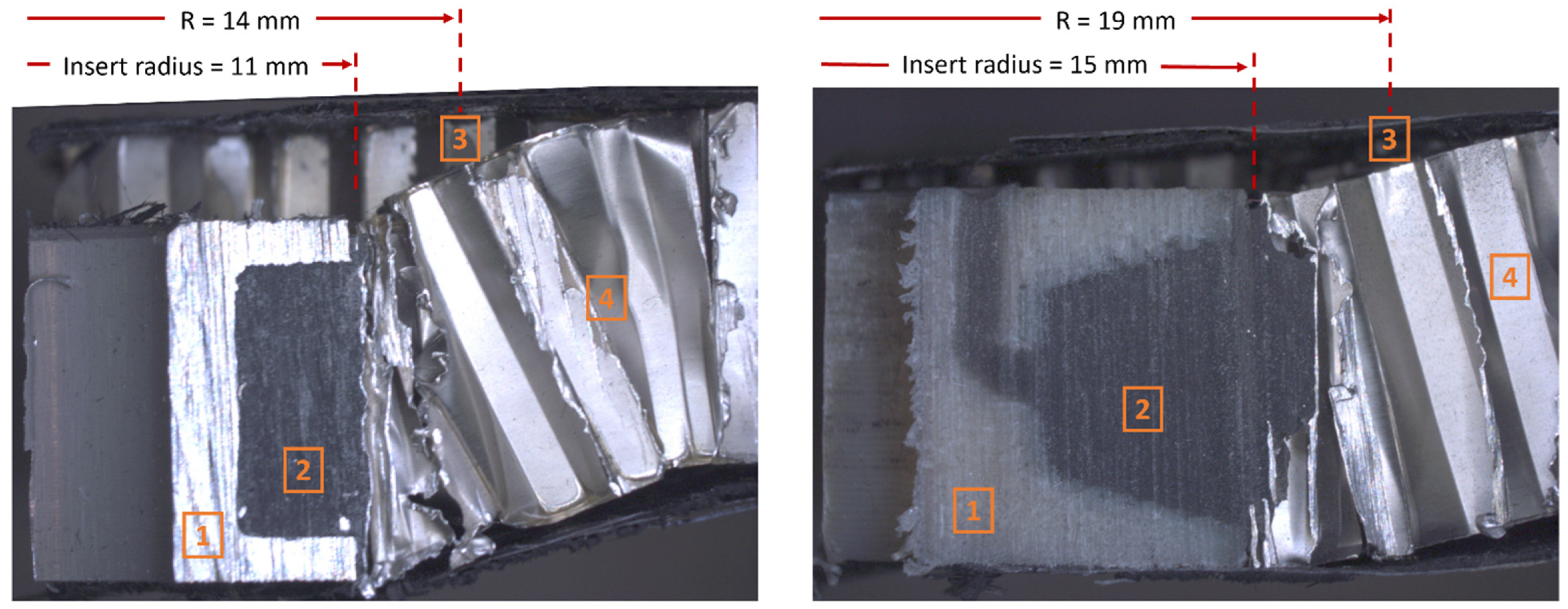
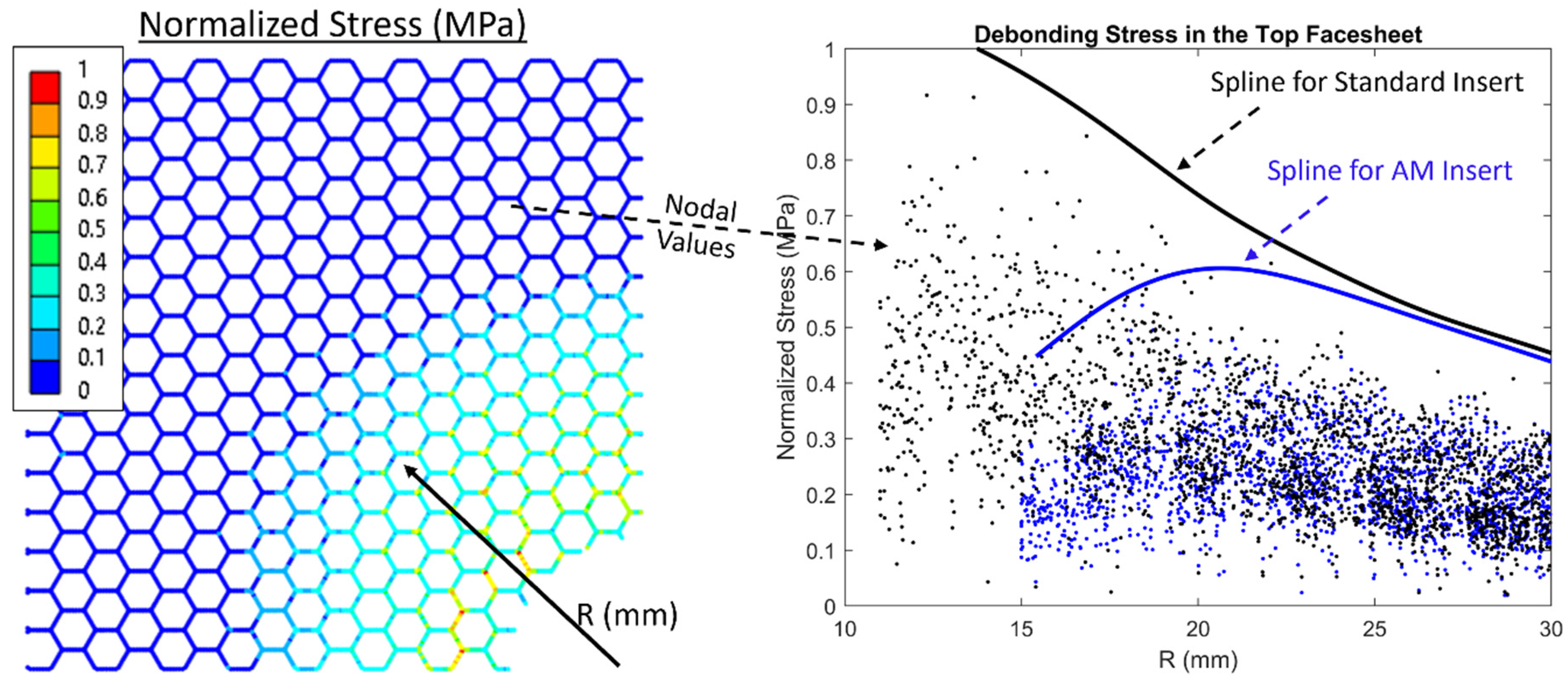
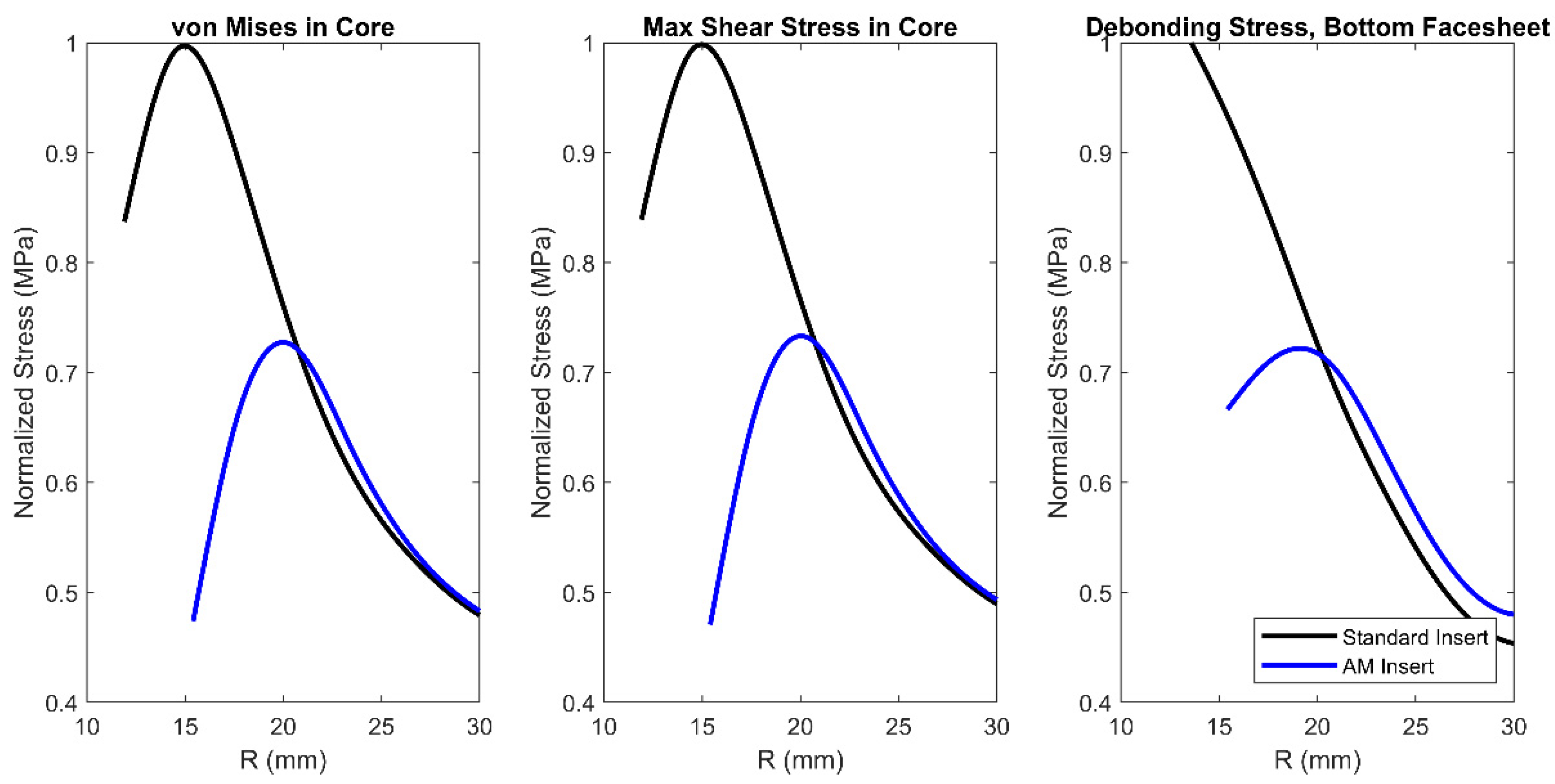
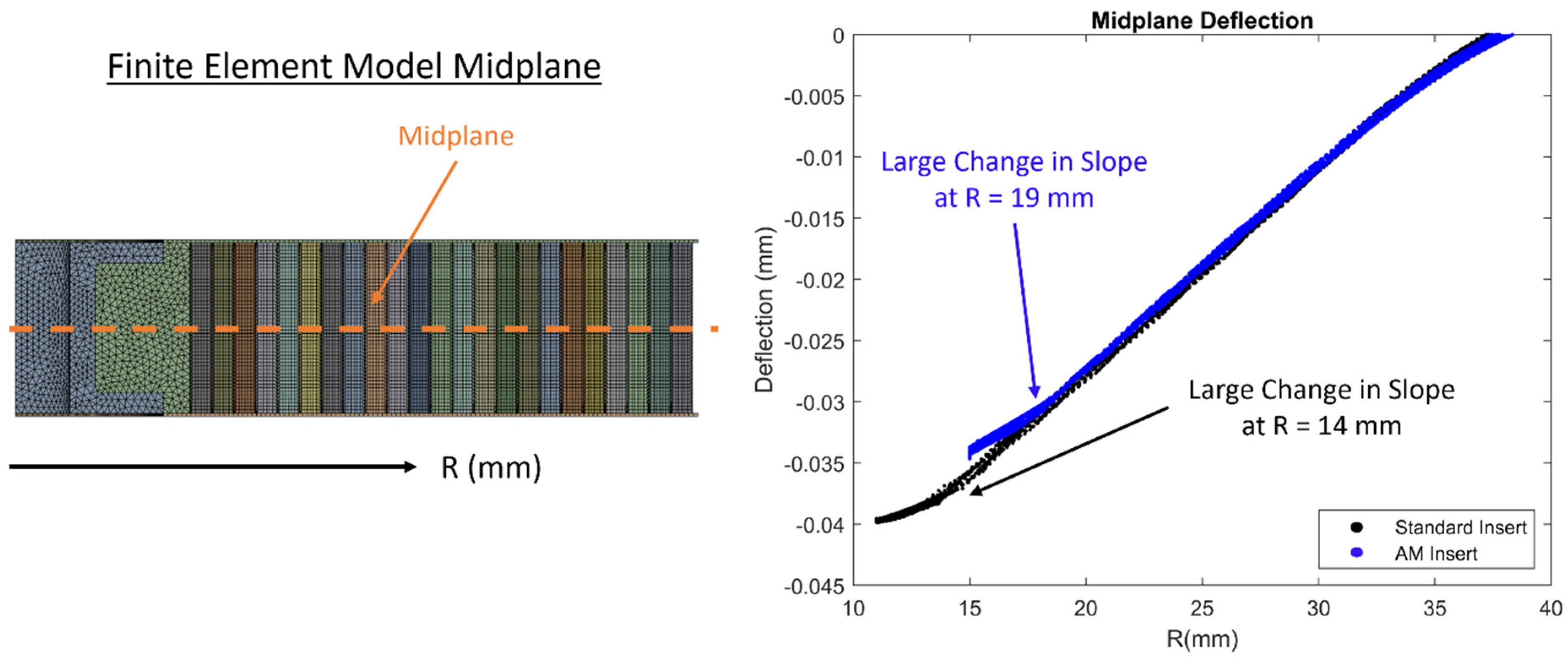
| Component | Mass (g) | Facesheet Thickness (mm) | Length (mm) | Width (mm) | Height (mm) | Volume (cm3) | Density (g/cm3) | |
|---|---|---|---|---|---|---|---|---|
| Standard Insert | Panel 1 | 27.7 | 0.33 | 101.6 | 101.6 | 13.0 | 134.3 | 0.206 |
| Panel 2 | 27.5 | 0.34 | 101.9 | 100.8 | 13.1 | 134.9 | 0.204 | |
| Panel 3 | 27.7 | 0.29 | 101.4 | 101.1 | 13.0 | 133.6 | 0.207 | |
| Mean | 27.6 | 0.31 | 101.6 | 101.2 | 13.1 | 134.3 | 0.206 | |
| AM Insert | Panel 1 | 31.7 | 0.32 | 109.1 | 104.2 | 13.1 | 148.6 | 0.213 |
| Panel 2 | 34.0 | 0.29 | 107.5 | 108.1 | 13.4 | 155.3 | 0.219 | |
| Panel 3 | 31.8 | 0.23 | 107.1 | 104.8 | 13.2 | 147.6 | 0.215 | |
| Mean | 32.5 | 0.27 | 107.9 | 105.7 | 13.2 | 150.5 | 0.216 | |
| % Increase for AM Insert | - | - | - | - | - | - | 5.0 |
| Material | Ex (GPa) | Ey (GPa) | Ez (GPa) | Gxy (GPa) | Gyz (GPa) | Gxz (GPa) | νxy | νyz | νxz |
|---|---|---|---|---|---|---|---|---|---|
| Facesheet: CFRP | 24.0 | 23.5 | 1.6 | 4.2 | 3.5 | 3.5 | 0.04 | 0.30 | 0.30 |
| Core: Aluminum 5052 | 1.7 | 1.7 | 2.4 | 1.0 | 0.5 | 0.3 | 0.99 | 0.33 | 0.33 |
| Fixture: Steel | 200.0 | 200.0 | 200.0 | 76.9 | 76.9 | 76.9 | 0.30 | 0.30 | 0.30 |
| Potting Material | 3.8 | 3.8 | 3.8 | 1.4 | 1.4 | 1.4 | 0.35 | 0.35 | 0.35 |
| Standard Insert: Aluminum | 71.0 | 71.0 | 71.0 | 26.7 | 26.7 | 26.7 | 0.33 | 0.33 | 0.33 |
| AM Insert: ULTEM 9085 Resin | 2.4 | 2.4 | 2.4 | 0.9 | 0.9 | 0.9 | 0.30 | 0.30 | 0.30 |
| Standard Insert | AM Insert | |||||||||
|---|---|---|---|---|---|---|---|---|---|---|
| Facesheets | Core | Insert | Potting Material | Fixture | Facesheets | Core | Insert | Potting Material | Fixture | |
| Element Type | Hex20 | Quad4 | Tet10 | Tet10 | Hex20 | Hex20 | Quad4 | Tet10 | Tet10 | Hex20 |
| Element Count | 48,630 | 365,321 | 27,762 | 73,550 | 4092 | 51,158 | 352,715 | 72,026 | 117,649 | 2202 |
| Node Count | 343,826 | 374,977 | 42,539 | 108,321 | 17,951 | 361,602 | 362,206 | 107,969 | 173,289 | 10,667 |
| Avg. Aspect Ratio | 1.7 | 1.2 | 1.8 | 1.9 | 3.1 | 1.8 | 1.2 | 1.8 | 1.9 | 2.4 |
| Component | Stiffness (N/mm) | Mean | CV% | Maximum Force (N) | Mean | CV% | Energy Absorption (J) | Mean | CV% | ||||||
|---|---|---|---|---|---|---|---|---|---|---|---|---|---|---|---|
| Test 1 | Test 2 | Test 3 | Test 1 | Test 2 | Test 3 | Test 1 | Test 2 | Test 3 | |||||||
| Standard Insert | 7811 | 9860 | 8251 | 8641 | 10.2 | 2715 | 2912 | 2473 | 2700 | 6.6 | 0.759 | 0.618 | 0.768 | 0.715 | 9.6 |
| AM Insert | 8710 | 9107 | 9951 | 9256 | 5.6 | 3864 | 4881 | 3647 | 4131 | 13.0 | 0.955 | 1.710 | 0.816 | 1.160 | 33.9 |
| % Increase for AM Insert | - | - | - | 7.1 | - | - | - | - | 53.0 | - | - | - | - | 62.3 | - |
Disclaimer/Publisher’s Note: The statements, opinions and data contained in all publications are solely those of the individual author(s) and contributor(s) and not of MDPI and/or the editor(s). MDPI and/or the editor(s) disclaim responsibility for any injury to people or property resulting from any ideas, methods, instructions or products referred to in the content. |
© 2024 by the authors. Licensee MDPI, Basel, Switzerland. This article is an open access article distributed under the terms and conditions of the Creative Commons Attribution (CC BY) license (https://creativecommons.org/licenses/by/4.0/).
Share and Cite
Severson, P.; Lutz, A.; Elhajjar, R. Pull-Through Behavior of Novel Additively Manufactured Sandwich Composite Inserts. Materials 2024, 17, 1884. https://doi.org/10.3390/ma17081884
Severson P, Lutz A, Elhajjar R. Pull-Through Behavior of Novel Additively Manufactured Sandwich Composite Inserts. Materials. 2024; 17(8):1884. https://doi.org/10.3390/ma17081884
Chicago/Turabian StyleSeverson, Patrick, Anna Lutz, and Rani Elhajjar. 2024. "Pull-Through Behavior of Novel Additively Manufactured Sandwich Composite Inserts" Materials 17, no. 8: 1884. https://doi.org/10.3390/ma17081884





